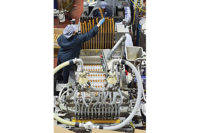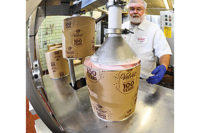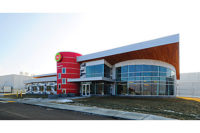Warren Taylor has designed some of the largest fluid milk plants in the United States for dairy processors. Then he designed and built one of the smallest for himself.
His Snowville Creamery in the foothills of the Appalachian Mountains is just 6,000 square feet. It’s assembled from modular buildings and second-hand equipment. The plant reflects his engineering philosophy: design for efficiency, don’t be dazzled by technology and buy only the equipment that’s needed.
Snowville Creamery, located at the edge of a dairy farm in Pomeroy, Ohio, manufactures fluid milk and cultured dairy products. It sources milk from grass-grazed cows from the adjacent farm and others in Meigs County and surrounding counties. Snowville sells the products in Ohio, Washington, D.C., Kentucky and Indiana.
After working for Safeway Stores (the supermarket chain with its own dairy processing operations) in the 1970s and 1980s, first as an employee and later as a consultant, Taylor returned home to Ohio where he set up Warren Taylor Services, a food plant engineering firm. Then he fulfilled his dream of becoming a dairy processor. He broke ground on his plant in December 2006 and it was in full production a year later.
Holistic dairy plant design
Taylor is a 1974 graduate of Ohio State University with a degree in dairy technology. At Safeway Stores, he learned how to design dairy plants from some of the best minds in the industry. They taught Taylor that dairy engineering isn’t about installing equipment and flicking a switch. A properly designed dairy plant consists of equipment that has been integrated into a cohesive and comprehensive system.
Taylor puts it this way: if you want to impress someone, you don’t say: “You have an incredible digestive tract.” You have to take in the whole person, he said.
Likewise with dairy processing. Good plant design “only works within the right three-dimensional relationship within a building. And that building only works within the right relationship to its surroundings. You’ve got truck-turning radiuses, and access to all of your materials and people coming and going. Everything has got to be right,” Taylor said.
Randall Dei, a Safeway executive who worked with Taylor for many years, said “he was and still is a brilliant process engineer.” Taylor was cost-conscious and spent money as if it were his own, Dei said. At Snowville Creamery, Taylor is spending is own money.
When Dairy Foods visited in October, Taylor pointed out some of the plant’s design details that he has used in other, larger facilities during his engineering career. The slot drain on the floor efficiently removes water from the processing room. Floor curbs (baseboards) with rounded radiuses in the processing room are free-draining and sloped. Taylor even made the stainless steel tooling to screed the concrete to make the shape of the curbs. He also installed curbs in the refrigerated distribution center in Columbus so that cold air can circulate behind pallets stacked with finished products.
Taylor designed the pasteurizing system himself and had it built by an outside firm. The homogenizer is not used on fluid milk (because Snowville sells cream-top products). Instead, it’s used as a high-pressure pump for nanofiltration to concentrate fat-free milk for yogurt products.
“We got that system when we were making Jeni’s Splendid Ice Cream. I’d rather be tied to a post and whipped than reconstitute dry milk powder into milk,” he said. (As Jeni’s Splendid Ice Creams grew, Taylor realized he did not have the capacity to make more mix and grow his own fluid milk and cultured business at the same time. He ended the relationship with the Columbus ice cream company and Jeni’s eventually found another mix supplier.)
Processing milk, yogurt
The processing area is small by design. It accounts for just 1,000 square feet of the 6,000-square-foot plant and office building. The small size reduces the daily operating cost (as well as the initial capital cost of construction), Taylor said. He also noted that a large room requires more water for cleaning.
The creamery owns one 2,300-gallon and one 5,600-gallon tanker. Drivers pick up grass-grazed milk on Monday, Wednesday and Friday. The creamery bottles milk on Tuesday, Thursday and Saturday. Cultured products are made on Wednesday and Friday. In the onsite lab, technicians (who also operate the processing equipment) run standard raw milk tests. They test for protein levels in yogurt, and perform first-, middle- and end-of-batch quality control tests.
Snowville only uses half-gallon paper cartons. Taylor points to the sustainability features of the cartons: they are recyclable and use just one-sixth of the polyethylene found in a plastic half-gallon jug. Using paper cartons also eliminates the need for separate labeling and capping machines. Cartons protect the milk from light. There is a quart filler in the basement of the plant ready to be installed once there is a building expansion to house it.
The creamery also makes chocolate milk, using only pure cocoa powder and sugar (and no stabilizers). Cultured products are filled on a separate filler that can handle 8-ounce to 32-ounce cups. Snowville uses 24-ounce plastic containers (instead of 32-ounce ones) for its bulk packages to keep retail prices lower. Cup-set dessert style yogurts are packaged in 16-ounce cups and crème fraiche in 12-ounce plastic containers. Taylor’s wife, Victoria, developed the yogurt flavors at her kitchen table. The creamtop yogurt SKUs include coffee-cardamom and lemon-ginger.
After the milks and cultured products have been filled, they pass by a code-date printer. Then, employees pull containers off the conveyor and manually case pack them. Company drivers later deliver the products to the distribution center where Whole Foods and other distributors pick up pallet loads.
Snowville drivers who service grocery stores use tablet computers.
“They inventory the store when they walk in,” Taylor said. “So we basically get a snapshot, not with a picture, but with numbers of what’s in the dairy case, what’s in the cold box, what the dates are of it.”
That information helps with customer service. Snowville now delivers three days a week (up from twice) to customers in Columbus that sell the most milk and have the fewest returns. These are the accounts that represent potential sales growth.
“By giving a higher level of service to the stores that were delivering the higher level of sales and virtually eliminating any returns, we’re giving our customers a fresher, more desirable product which we believe is sufficient to continue to increase our sales,” Taylor said. “We succeed in getting a lot of milk into people’s hands at two to three days by tightly managing the inventory at the store. But that’s a continuous struggle. It’s a continuingly variable operation. It depends on the quality of the people at the store, how they rotate, how they stock, how they order.”
Building the plant
Taylor knew from the start that he had to keep construction costs down. His original idea was to put the processing room inside a metal Quonset hut. That evolved into an idea about using sea-going containers. Then an architect friend convinced him that a pole barn was the way to go. Taylor resisted.
“I’ve been designing industrial dairy plants for too long to accept the idea of a pole barn on the first take. But he’s smart, and the more I thought about it, the more I saw the merit in it,” Taylor said.
It was the least expensive way to build and the simplest, too. The availability of tradesmen and materials in southern Ohio was limited, he said. The barn was built on 10-inch-thick reinforced concrete walls that are 4 feet high at the lowest part.
“The pole barn starts 4 feet off the ground, so that way it’s vermin-proof. It’s not like the metal’s down close to the ground [where it could] start rusting in 30 years,” he said. Compared to metal buildings, “the pole barn is actually tidy and trim.”
Six-inch insulation was force-fit into the roof trusses under the metal roof to make the building hyper-insulated and rigid, he said.
“I was experimenting with the idea of using a container as a processing room,” he said. That didn’t work out but he kept the containers. He calls them his “container containers” because that’s where he stores milk cartons and yogurt cups.
The administrative offices and dairy lab are located in two 30-year-old GE Capital used double-wide school buildings. As Taylor was putting his plant together, he called his old industry contacts. They sold him equipment sitting in their “bone yards” and he scoured auctions for what he needed.
“It’s a long list of buddies that have kept us in business. We put together a nanofiltration system for $50,000 or $60,000 that probably would have cost us north of $150,000 if we’d called up XYZ and had them quote a system,” he said.
The milk filler came from the supplier’s testing laboratory.
“I bought a brand-new pasteurizing system that I designed myself. When we started out, the pasteurizer was doing 5 gallons a minute. Now it’s doing 25 on the same frame. Never in my wildest dreams would I have imagined we’d ever push that more than 25 gallons a minute.”
“We have programmable controllers and automation throughout the plant,” Taylor said. “We had none of that when we started. We literally controlled the temperature on the HTST by throttling a hand valve on the recirculated hot water. Over time, we bought cheap, generic PLCs and programmed them ourselves.”
Dealing with waste water
The site’s rolling terrain was another aspect Taylor had to contend with.
“There’s no flat land in southeastern Ohio, so the concept of the building included taking advantage of the slopes of the soil,” he said.
Waste water is used for irrigation water on the neighboring, adjacent pastures. It is collected in a sub-tank in the basement then pumped to a larger 6,000-gallon tank where the water is neutralized for pH. It is then used for irrigation on the fields of the neighboring dairy farm.
As Snowville grew, wastewater disposal became a problem. The wastewater system was approaching the maximum limit of an EPA-permit for spray irrigation. Taylor turned to his alma mater to find a solution. Ohio State University requires all undergraduate engineering students to participate in “experiential” learning. Four students undertook Taylor’s challenge.
They put meters on every water source in the plant to determine exactly how much water was being used in each area. They found that the raw milk separator used 1,300 gallons of water each time it was turned on. By installing a recirculation loop, Snowville eliminated waste during startup and shutdown. The loop saved more than 4,000 gallons of water a week, according to a report by the university. The students also redesigned the plant’s clean-in-place automated chemical flushing system to enable rinse water reuse. They also cleaned up the nutrient-rich water so it could be fed to the cows instead of causing potential soil problems. The team projected that the new plan would save 23,500 gallons of water per week and more than $8,000 per year.
Snowville Creamery is a work in progress. There is always something to fix or add. The Creamery needs a bigger pasteurizer, but it will wait for the building expansion, Taylor said. Sales have to justify the investment.
It’s hard to replace a pasteurizer in a one-pasteurizer plant, he said.
“We’re going have to do the building expansion. You build out that pasteurizer, bring it up on water then cut it over. I’m looking forward to buying one of those new cold milk CIP-able separators the Italians have just brought in to America. I went to Italy last summer to see their second prototype.”
Will Snowville ever be as large as a Safeway plant? Don’t bet on it. But you can wager that Taylor’s operation will be just as efficient and well designed as any fluid plant in America.
At-A-Glance
Photos by Vito Palmisano








